Welcome to October! Here we are, with a brand new pack of cards and a scant four weeks until Worlds. Inevitably the questions arise, what will the meta look like? Isn’t BOOM! stupid? How will I fit my third Plascrete Carapace? 46 cards is acceptable, right?
In this tumultuous time I humbly suggest that you, dear uncertain reader, consider adding Nexus Kate to the list of decks that you will sleeve up, not find time to practice, and then leave at home as you decide to just play Dumblefork because what the hell, it did well at Regionals.
“But wait!” you say. “Nexus Kate is easy. All you ever do is mash Magnum Opus and run R&D, Ethan. Any monkey can do that.” Well. Perhaps so. But if I may flatter myself, I believe Nexus Kate is actually a much more interesting and thought-intensive deck than many players realize. Allow me to explain why.
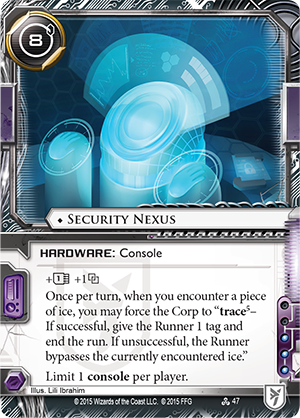
Notable Finishes
First, some credentials, lest you doubt this archetype’s potential. Piloted by myself and others, various iterations of Nexus Kate have gone on to have success at several large tournaments, including: 22nd at Worlds 2015; 2nd at HAC ANRPC 2015; 7th at Philadelphia Regionals 2016; 2nd at NYC Regionals 2016; 4th at Gencon 2016; and 1st at SMC ANRPC 2016.
The Basics of the Deck
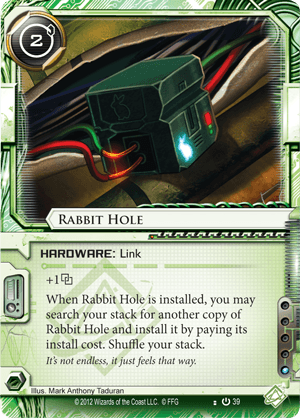
I have heard Nexus Kate described as the Glacier of Runners, which I think is apt. The deck is not disruptive. It does not aim to kill the Corp, mill them out, or siphon them to nothing. Instead, it builds. It builds a board state that makes it unprofitable for the Corp to pursue their game plan, locks servers down, and never loosens its grip. It has one of the strongest endgames out there, with room for silver bullets for any Corp you might worry about. Let’s break it down.
The Core Engine
The beating heart of this deck is, of course, Security Nexus itself. With Kate’s base link, three link from Rabbit Hole, and one link from Nexus, you have a flexible bypass each turn that costs only as much as the Corp is willing to pay. Because Nexus is so central to your game plan, you want at least two in your deck. Three, however, is prohibitively expensive on influence. So, we’ll Take Two. Of course you play the full set of Rabbit Holes.
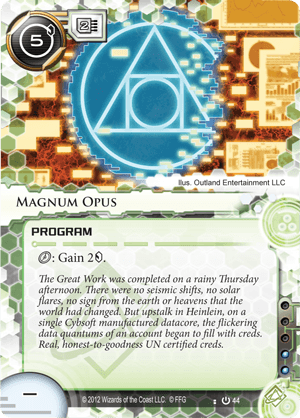
Economy
The core of your econ is Magnum Opus. It is slow, but reliable and infinite. With a Magnum Opus and enough time, you can out-money almost anything. Unfortunately, Magnum Opus isn’t always enough. The first card to consider for additional econ is Modded. It provides greater value per click than Sure Gamble, and works on Magnum Opus, Nexus, R&D Interface, and breakers. Beyond that, other considerations include Sure Gamble, Underworld Contacts, Daily Casts, Dirty Laundry, and Beth Kilrain-Chang.
Beth is a must-include, at least as a one-of. Beth’s power is undeniable in any Shaper deck, but she is particularly potent in a Magnum Opus deck. You will frequently be getting extra clicks that help you set up, and catch up on money, faster than any other drip econ. Contacts will likely net you the most money of the remaining options, but it is the least reliable. It does nothing turn one, and can’t be used early to keep your credit pool above four or six (the thresholds needed to hard install Opus or tutor for it with Self-Modifying Code, respectively) if you have a bad draw. It is also rarely worth installing before you have Rabbit Holes online, meaning it can end up just sitting in your hand or in the bin. In short, Contacts is high risk, high reward.
Daily Casts is faster and more reliable than Contacts, but nets less money in the long term and similarly lacks Sure Gamble’s burst potential. Dirty Laundry provides some burst early and can transition to clickless money late, but its flexibility is offset by its relatively low value – making a run can often be useless and can even be a drawback in the early game. In choosing econ cards beyond Magnum Opus and Modded, you will need to understand what you are comfortable with, and what your deck can support based on the speed of its set up; more tutoring and draw makes it easier to justify Contacts over Sure Gamble. I recommend 3-6 econ cards beyond Magnum Opus, Modded, and Beth.
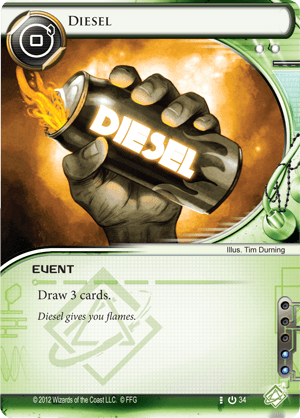
Draw, Tutoring, and Recursion
Because the core of this deck has a lot of moving parts (at a minimum, against most decks you’ll want to install a Magnum Opus, Rabbit Holes, and Security Nexus), you’re going to need powerful draw and tutoring to find everything quickly. Three Diesels is fairly obvious. Beyond that, Earthrise Hotel and Quality Time are typically the go-to choices. I prefer Earthrise Hotel, because it doesn’t fill up your hand all at once. This means you can spend turns installing one or two cards and then building up your credit bank. Quality Time is excellent if you find yourself with a small hand or need to find a specific piece immediately, but Earthrise is generally better while you’re setting up, when draw is more important. Furthermore, Quality Time is the most likely to draw you into two Rabbit Holes, which you want to avoid in order to install all three in a single click. For that reason, I typically run 2-3 Earthrise, and 1 Quality Time.
For tutoring, you will of course want 3 Self-Modifying Codes. Beyond that, I am a firm believer in the importance of having a tutor for Security Nexus. Especially when preparing for a big tournament, building around a single card with only two copies in the deck is reckless. You need to accept that sometimes both Nexuses will be buried and prepare for that. Your two options are Trade-In and Artist Colony. Trade-In is reliable but inefficient, while Artist Colony is powerful but unreliable. Artist Colony also typically takes more slots in your deck because you’ll generally want to play some number of Fan Sites. I personally am in the Artist Colony camp, but believe Trade-In is a defensible choice. Fan Sites are very powerful if you can fit them, but either way you should be prepared to sacrifice real agendas to find what you need.
Finally, recursion. Clone Chips are your obvious choice. In addition, finding room for a singleton Scavenge can be quite useful, especially to reset breakers like Cerberus “Lady” H1, Cyber-Cypher, Atman, or Femme Fatale. I have spoken to people who have suggested Test Run, as an additional tutor for Magnum Opus and because of its synergy with Scavenge; I don’t think Test Run is worth it. It takes up too many slots for a card that will have little-to-no impact in most games.
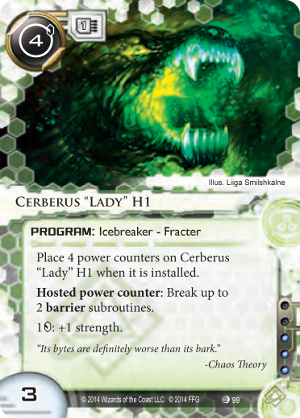
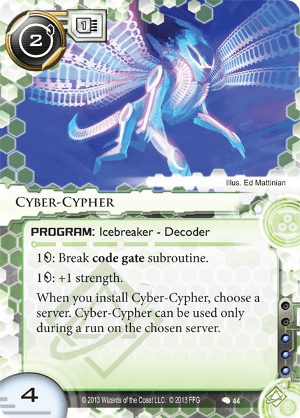
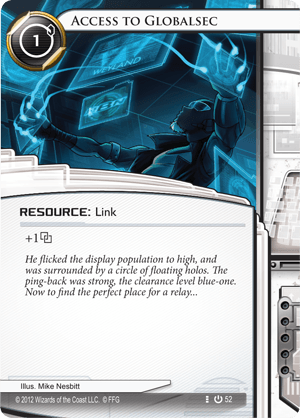
Breakers
Upfront, let me say that one of the most common mistakes I see people make with Nexus Kate is overvaluing their breakers. Your main breaker is Security Nexus plus link. Everything else is backup, and should be installed strictly on as as-needed basis. This is especially true in a meta that features lots of tracer ICE. From here on out I will assume that you know that you don’t need to break Gutenberg or Turnpike when you have 5 link, and won’t be factoring tracer ICE into my analysis.
With that out of the way, you will of course need breakers at some point. Let’s start with Fracters. Depending on the meta, a single Lady can be enough, especially with a Scavenge to reset her in a pinch. In the current meta however, where NEXT ICE and Vanilla are seeing play, Inti is valuable as a permanent, cheap barrier solution. I suggest Lady and Inti, and maybe a Scavenge if you can fit it. For Decoders, the most common package is Zu.13 Key Master and Cyber-Cypher. The Cloud text of Zu, which reduces its memory cost to zero, should not be underestimated. Cyber-Cypher is a great answer for the big code gates like Tollbooth, DNA Tracker, and Little Engine when Nexus isn’t available. Alternative Barrier and Code Gate solutions, such as Snowball or Gordian Blade, are typically too expensive, both in install cost and in breaking common ICE, to be worth considering. Looking to AI breakers, a single Atman is standard for its versatility.
Choosing a Killer is a bit more complicated. The four most common solutions I have seen are Mimic, GS Shrike M2, Femme Fatale, and skipping out on a Killer altogether. I think any of these four can be the right call, depending on your deck and the current meta. Mimic is great because it’s cheap on influence, and answers most sentries that Nexus, link, and Atman 4 don’t answer. Shrike is reliable in its ability to break anything and is the best answer to Tour Guide when Nexus isn’t available, but is expensive to install, expensive on influence, and inefficient against many common sentries (notably Architect). Femme Fatale I think is a poor choice. The install cost is very high, the bypass ability is less valuable than for most decks because of Nexus, and the pump cost is extremely high. I do not recommend it.
Finally, skipping out on a permanent Sentry solution entirely is a viable route but requires caution and a decent sense of the meta. You need to know what sentries you are likely to face and what your answers to them are, either by clicking through them, by Nexusing them, or by Atmaning them. This route becomes more manageable if you have Deus X or Sharpshooter in your deck as a panic button solution to scary sentries, but neither are strictly necessary.
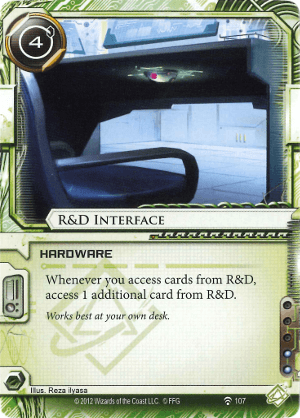
Multi-access
Your big multi-access piece is typically R&D Interface. This deck can develop a very tight R&D lock that is extremely difficult to break, which makes RDI a better choice than The Maker’s Eye. You aren’t making power runs, you’re making repeated and efficient runs. In addition, I have seen some people slot Indexing. I don’t think Indexing is a replacement for RDI, both because it doesn’t grant you the consistent lock that R&D does, and because a deck that relies on Nexus as a breaker can sometimes struggle to make two runs in a turn. As a one-of though it seems fine, if you can fit it.
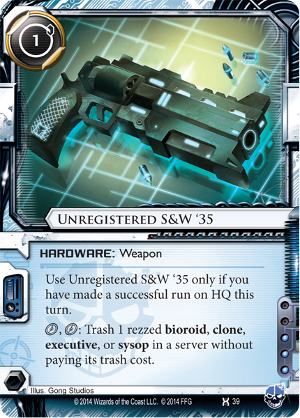
Silver Bullets
Plascrete Carapace is good and I hope I don’t have to explain why, especially in a BOOM! meta. An alternative solution to meat damage is New Angeles City Hall to avoid getting tagged in the first place, plus Film Critic to avoid Stealing agendas and thus prevent NACH from trashing itself. I think NACH and Film Critic is an extremely strong solution because it allows you to avoid Breaking News shenanigans, speed up Hard-Hitting News recovery time, and turn off Midseason Replacements if you don’t yet have the money to combat the trace. However, as one-ofs that work in tandem, I don’t think you can afford to play NACH and Film Critic unless you are also playing Artist Colony to tutor for them.
In addition, there are several silver bullets you can play based on your expectations of the meta. Salt to taste:
- Clot is excellent for Fast Advance, which is still a thing! #SlotTheClot
- Sacrificial Construct lets you run through program trash subs if you have to, and keeps Clot alive through Cyberdex Virus Suite. Well worth a slot as general rig protection and Fast Advance hate.
- Paricia (or Scrubber if you have the influence) is good in an asset spam meta like the one we have now. The MU cost often won’t come up, as the matchups where it is most important are often the ones where you least need breakers. Against CtM, this can be worth 2cr/turn drip at zero install cost. The asset limitation of Paricia can be inconvenient, but Scrubber is more vulnerable and harder to tutor. I generally prefer Paricia.
- Vamp is a generally strong tool, but is particularly damaging to an unprepared Cerebral Imaging combo deck or to Glacier decks. Setting the Corp back to zero is valuable in an Opus deck because you can recover from zero faster than the Corp (meaning Nexus traces are going to remain easy to win), and because it prevents the Corp from rezzing more ICE (meaning your runs, even through heavily ICEd servers, remain efficient).
- Political Operative answers Jackson, Caprice, or anything else you want to trash. It’s also tutorable with Artist Colony. At one influence, it is an excellent flexible solution to a range of problems.
- Rumor Mill is also an alternative to Plop and answers several high impact cards, including Jackson, Caprice, and Sandburg. It’s influence-heavy though, and at its best if you can find room for a Same Old Thing to recur it. As a non-tutorable one-of, it less reliable than Plop but capable of doing more damage to the Corp.
- Employee Strike costs less influence than Rumor Mill, turns off pesky Corp currents, and is good-to-great in a wide range of matchups. Similarly improved by SOT. Employee Strike is great against asset spam IDs, but is usually just an inconvenience to Glacier or Fast Advance decks.
- Deus X or Feedback Filter are great net damage solutions. Deus X is easier to tutor, cheaper, and can double as an icebreaker, but lacks the permanence of Feedback Filter. Because of its high cost, I do not recommend Feedback Filter unless you’re also playing Contacts for sustained drip econ.
- Sports Hopper is mediocre damage protection, ridiculously costly card draw, and an extra link that is almost entirely superfluous once you have Nexus and Rabbit Hole installed. In short: it’s not very good. I don’t recommend it.
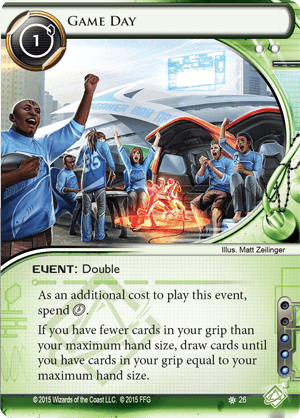
What Dogs is Testing
Turquoise Kate (BOOM! Meta)
Kate “Mac” McCaffrey: Digital Tinker
Event (8)
3x Diesel
1x Employee Strike ●
2x Modded
1x Quality Time
1x Vamp ●●
Hardware (10)
2x Clone Chip ★★
3x R&D Interface
3x Rabbit Hole
2x Security Nexus ●●●●● ●
Resource (14)
2x Artist Colony
1x Beth Kilrain-Chang
2x Earthrise Hotel
2x Fan Site
1x Film Critic
1x New Angeles City Hall
1x Political Operative ●
1x Sacrificial Construct
3x Underworld Contact
Icebreaker (5)
1x Atman
1x Cerberus “Lady” H1 ★
1x Cyber-Cypher
1x Inti
1x ZU.13 Key Master
Program (8)
1x Clot ●●
3x Magnum Opus
1x Paricia
3x Self-modifying Code
12 influence spent (max 15-3★=12, available 0)
45 cards (min 45)
Cards up to Blood Money
Applying what we discussed above, you can see that I chose to supplement Magnum Opus and Modded with three Underworld Contacts and one Beth. A second Beth would be great but the slots don’t exist for her when she’s not crucial to the game plan and the second draw is dead. I found room for the full Fan Site/Artist Colony package, which gives me speed to find pieces and allows me to play the ultimately more powerful Underworld Contact over the more reliable Sure Gamble. The Artist Colony package also lets me run the New Angeles City Hall/Film Critic package, which protects me against Power Shutdown BOOM! combos and Midseasons. Unfortunately the two cards this requires, compared to Plascrete’s one, means that I had to drop down to two Modded. I think this is worth testing, even if it may not be the correct choice. Notably, Scarcity of Resources is more damaging to this resource-heavy build than it is to more event-based builds.
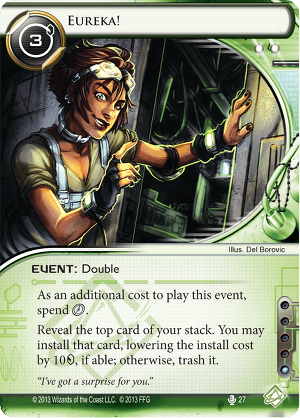
General Advice
Luckily for you, the decision of whether or not to mulligan with this deck is incredibly simple. Since money is the most important part of getting yourself set up, the vast majority of the time you want to keep a hand with Magnum Opus or SMC in it, and mulligan any hand that doesn’t have those. Exceptions can be made if you are playing Sure Gamble and have a really strong opener that includes Sure Gamble, Diesel, and Nexus and/or Rabbit Hole. If you are not playing Sure Gamble, you mulligan just about 100% of the time that you don’t have Magnum Opus or SMC in your opener.
Moving past that to actual gameplay, the most important thing to understand about this deck is pacing. You want to take it slow, not stress too much, and just let yourself get set up. Maybe you poke a bit against HB just to force rezzes, but in general your main goal is to get set up. So relax, accept that the Corp will probably score an agenda or two before you get the lock going, and get yourself ready for the endgame where you say “Take six, run R&D” over and over again until you win.
But on the other hand, you can’t take it too slow. Strong Corp players will put you on a clock, and you need to keep up. Sometimes you have to make runs and install breakers before you’re set up, and that’s okay. Somewhere between the “throw caution to the wind and run like mad” mentality you need against Russian NEH and the “click Opus over and over until you have infinite money” strategy against pure Kill Weyland is the sweet spot that you’ll need to reach against most Corps. You’ll find it easier the more you practice each matchup.
Beyond that, it’s important to understand that breakers are backups. You should feel comfortable discarding them when you overdraw (you can always clone chip them back if necessary), and you should avoid installing them before necessary unless you have nothing better to do (e.g., if you have a comfortable credit total and can install a Zu.13 for free after Kate discount, and without spending MU).
Finally, learn when to stop setting up. If you have Rabbit Holes, Nexus, Magnum Opus, Self-Modifying Code, and RDI installed, you probably don’t need to install an Earthrise Hotel. There likely isn’t anything you need to draw into to win, so focus on maximizing what you have rather than on adding new cards you don’t need.
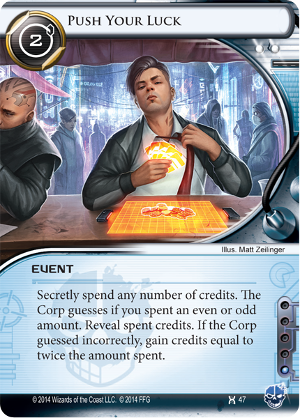
Matchup-Specific Advice
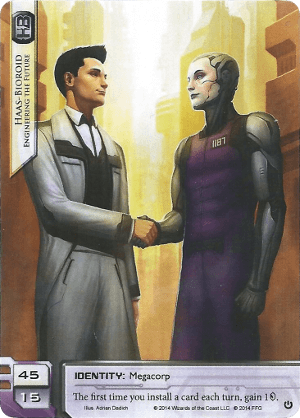
Engineering the Future
This is a decent matchup for you. The most important thing is to set up quickly. HB has the tools to score fast, so they’re likely going to get agendas scored while you set up. Making the occasional poke if they’re relatively low on credits can force them to money up before scoring and might net you an agenda or two, especially since most of their ICE isn’t too scary to face check. If HB has 4 or fewer points when you finish setting up, you’re in good shape. If they have 5 or more, you may be in for some unpleasant Never Advance games. You can typically float tags taken from Nexus if necessary, as tag punishment beyond killing Beth is generally minimal.
If You’re Struggling: Mimic is a great include to answer Architect and free up Atman to put at strength 4. Drip econ is extremely valuable to take the burden off of repeatedly checking a remote to stop the Never Advance game, which means Underworld Contacts is a great choice. Vamp does huge work here.
What Not to Play: Femme and Shrike are not great choices here, as the cost to break most sentries will be too high. NACH and Film Critic do nothing against most EtF builds as well.
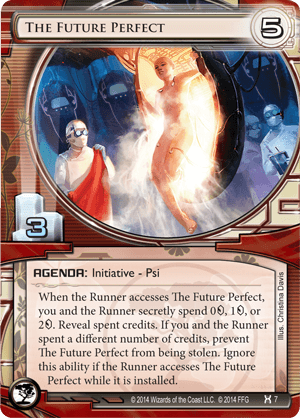
Palana
Similar to HB, you want to get set up as quickly as possible and then start locking remotes. It’s a bit more dangerous to face check here, because Jinteki’s ICE can be quite spiky. But, Palana has a slightly weaker rush game and minimal never advance threats. Rumor Mill and Political Operative are big here, and the ability to tutor Plop with Artist Colony wins games. Defensive upgrades are generally scarier here than in EtF, because link doesn’t blank psi games the same way it does Ash, but it is still in Kate’s favor.
If You’re Struggling: Deus X or Feedback Filter are great against the spikier builds to prevent damage, and for Deus X to break ICE. Plop and Rumor Mill are big for killing defensive upgrades. Vamp as well; you can’t play a PSI game with zero credits. Film Critic is great against The Future Perfect agenda suites. Mimic is an excellent choice of Killer, and Shrike is fine against Komainu.
What Not to Play: Like EtF, NACH isn’t doing anything for you.
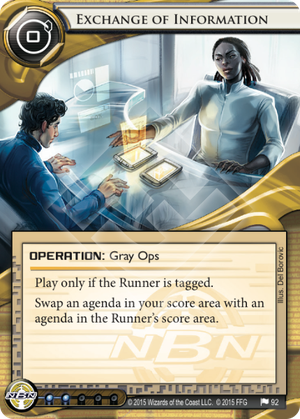
SYNC and Sol
This is a great matchup for you if you play it right, but a good SYNC player will punish mistakes hard. So, it can look bad if you don’t understand it. In the early game, you don’t want to make runs because Hard-Hitting News can be backbreaking, and because stealing agendas early on isn’t always good in a world where Exchange of Information exists. Instead, you want to be drawing aggressively to set up. This means you may be a bit low on credits, but that’s fine; it makes Closed Accounts less valuable. Once you have the Nexus combo and Clot threat online there’s not much SYNC or Sol can do, though Sol can slow down development somewhat with Targeted Marketing or Scarcity of Resources. This is a matchup where you will only rarely actually install a breaker. Most of the ICE is tracers that you can pretty much blank, and what few ICE isn’t you can bypass with Nexus. Just be cautious in the early game, and you should be good.
If You’re Struggling: Artist Colony is extremely important to this matchup. It is often the right play to sacrifice real agendas to Artist Colony in order to prevent Exchange of Information blowouts. Burst econ is slightly better than drip econ because it’s less vulnerable to tag punishment. NACH lets you remove tags cheaper and faster.
What Not to Play: Breakers. You may need Inti to deal with Wraparound, and occasionally will need Zu.13 or Cyber-Cypher to deal with an Enigma or Quandary, but the vast majority of their ICE is answered by 5 link. You will pretty much never install a Killer. Rumor Mill and Plop have limited utility, with Jackson being the only common target.
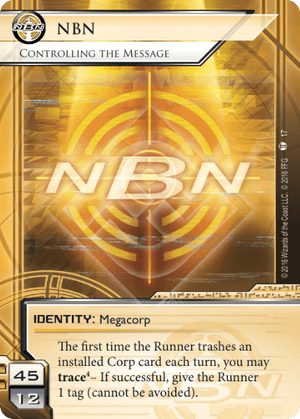
Controlling the Message
This is similar to SYNC, but more difficult because political assets force you to make early runs, which slows you down and makes you vulnerable to Hard-Hitting News. Once you have Magnum Opus online, you generally want to pay through the trace to avoid the CTM tag, as it ends up being cheaper than taking the tag and then clearing it next click. Rabbit Holes are extremely important in this matchup, as once they’re online the ID ability is mostly blank. This is a matchup where you should consider mulliganing an otherwise mediocre hand that includes Magnum Opus, as the matchup can often be decided by how early you find your Rabbit Holes. Political assets are must-trash, even if you haven’t found Rabbit Holes yet. Early game, it’s generally okay to float tags for a turn or two, as the Corp’s punishment options will be limited. This matchup often feels as though it’s decided by the first 3-5 turns.
If You’re Struggling: Because the early game is so essential, Sure Gamble is generally your best supplementary econ. Employee Strike gives you a fourth card early (beyond the three Rabbit Holes) to turn off the ID ability. Paricia is tremendously valuable in keeping your credit total up, and will be used frequently. NACH is big for avoiding most tags (but not ID ability tags, remember!)
What Not to Play: Killers. No need to install a Sentry solution beyond link and Nexus. CtM builds often have more hard End The Run ICE than SYNC, so you will find yourself installing Fracters and Decoders semi-frequently. Rumor Mill and Plop have limited value.
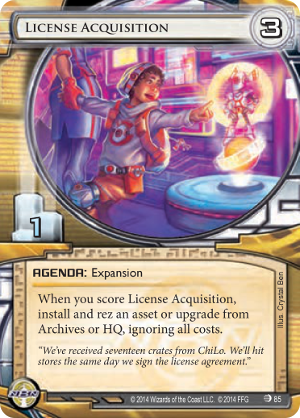
Russian NEH
This is a matchup where your normal setup time is too slow. Get Magnum Opus down to feed your econ, get Paricia down if convenient to trash the must-trash assets, and otherwise just go for as many central accesses as you can. Big targets for trashing are Team Sponsorship and SanSan City Grid. Barring an absolutely perfect draw, you’re just going to have to accept that a lot of your deck is blank cards, and hope you win off the NEH slot machine before the Corp does. This is not a great matchup for you.
If You’re Struggling: Paricia is really valuable here, it may even be worth running multiples. Clot slows down the scores, and SacCon stops CVS purges. This game will likely be over quickly one way or another and the ICE is typically weak, so you want burst econ like Sure Gamble.
What Not to Play: Weirdly, Rabbit Hole and Nexus are often too much of a tempo hit to be worth installing. Vamp is pretty worthless in this matchup, as they have lots of assets to rez in order to duck it, and are capable of scoring from zero. Film critic and NACH just waste time. Killers typically aren’t too important.
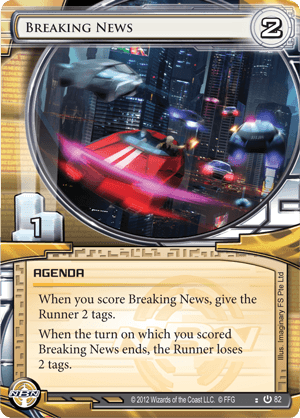
Butcher Shop
This is a pretty good matchup for you. You can Clot lock them to prevent scores, and they have limited Fast Advance tools to force you to speed up too much. And, with Magnum Opus (and hopefully Film Critic), you can make Midseasons a non-issue. Power Shutdown BOOM! combos can be scary, but if you have New Angeles City Hall then you can safely avoid the tags from 24/7 News Cycle and be fine. Bonus points if you install NACH after they Power Shutdown by using Artist Colony! Just keep in mind that even with NACH and Film Critic, you do want to pay attention to the money race. Many Power Shutdown decks are running Hatchet Job to get rid of NACH, so make sure you have the money to beat that trace.
If You’re Struggling: Clot keeps them off the scores, which keeps them off 24/7. NACH keeps them off Breaking News shenanigans. Film Critic keeps them off of Midseasons, and keeps NACH alive. Plascrete keeps you alive.
What Not to Play: Killers aren’t doing much here. Net damage protection cards are blank draws.
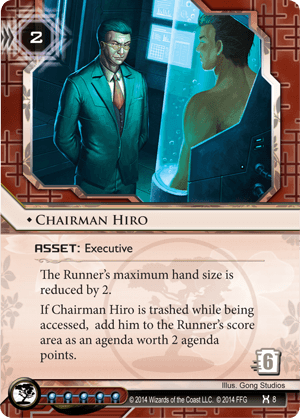
Industrial Genomics
This matchup is just awful if you don’t have net damage protection. If you find Employee Strike and Paricia early you can try to slow down their development, otherwise you should treat this as similar to Russian NEH and just go for a lot of central accesses early before you lose. With Deus X in your deck, you should make sure you can get access to it at any time so you can delay the kill turn. If you have Feedback Filter and drip econ in your deck, you can try to just turtle and go for occasional accesses until you win. Overall a bad matchup, but varies quite a bit based on your tech.
If You’re Struggling: Play Deus X or Feedback Filter to prevent damage, Plop or Rumor Mill to kill Chairman Hiro (or Ronin with Plop), Paricia to trash assets, and Employee Strike to turn off the ID ability. Indexing is amazing in this matchup. Sports Hopper is actually okay here as an answer to Ronin.
What Not to Play: Nexus and Rabbit Hole are typically not worth the time. Clot does nothing. Fan Sites aren’t doing anything because IG won’t be trying to score.
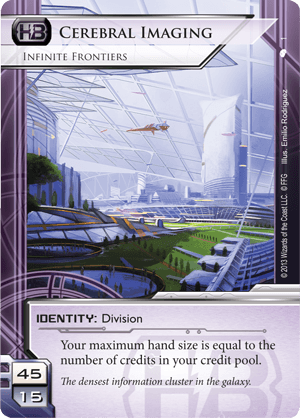
Cerebral Imaging
You can’t really put together a power turn, unfortunately. Go for lots of accesses early, until you suspect they’re near ready to combo. At that point you should stop running, install RDIs, and find your Vamp and Clot threat (plus Sacrificial Construct, ideally). Then you want to Vamp them to 0, take accesses, threaten clot, and hope they don’t have the answer. Very dependent on specific tech, not a great matchup but not terrible either.
If You’re Struggling: Vamp, Clot with SacCon, and Employee Strike are all great answers. Rumor Mill is good, too.
What Not to Play: Killers. Plop does nothing because you’re not Leela. Damage protection (unless up against a Scorch/BOOM! variant).
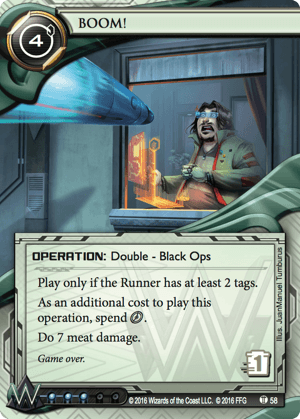
BOOM! Blue Sun
Blue Sun can make disgusting amounts of money extremely quickly with Oversight AI, Consulting Visit, and Orion/Curtain Wall. But, you can make disgusting amounts of money with Magnum Opus, and you can ignore a piece of big ICE each turn, which forces them to spend more money on rezzing ICE. Their scoring plan is terrible when there are no defensive upgrades and you’re bypassing the expensive ICE. So, you can generally be patient and set up. Once you are set up and have relative economic parity, you are in a extremely favorable position to win the game.
If You’re Struggling: Scavenge to reset Lady is nice. Plascrete is great damage protection. Film Critic and NACH will pretty much completely turn off tagging. A well-timed Employee Strike can be backbreaking.
What Not to Play: Clot shouldn’t be necessary. Rumor Mill, Plop, and Paricia are all-but blank.
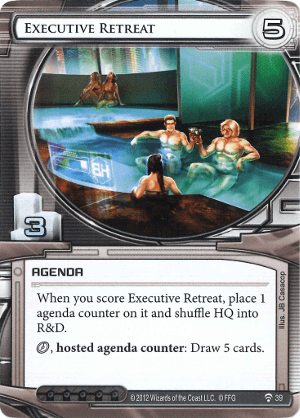
Gagarin
Control the political assets early game if you can, but make sure to remain above 8 credits to remove Hard-Hitting News tags. Eventually the asset spam will get out of control, but you want to slow that down while you set up. Learning to recognize when to give up on board control is important. Getting Plop down early is nice so you can trash important assets (like Mumbad Construction Co.) without making a run. The ICE is extremely taxing, so you’re not going to be trying to lock R&D. Instead, you want to get down 2-3 RDIs and make power runs once R&D has high agenda density.
Gagarin generally doesn’t have the influence for Midseasons, which means you can remove tags if you survive the turn they’re landed. This means a Plascrete buys you extra attempts to win, as they can’t HHN → Kill in one turn, or SEA Scorch Scorch through a Plascrete. Mumbad Construction Co. is their score-out win condition, so you want to kill it. This matchup ranges quite a bit depending on what kind of tech you’re running.
If You’re Struggling: Play NACH, Film Critic, and Plascrete. Shrike is the best solution to Tour Guide. Plop and Rumor Mill can turn off Museum of History Sandburg, which is a potentially backbreaking card. Inti gives you a reliable (if expensive) answer to Hive. SacCon helps a lot with turning off CVS purges on FA turns, and with handling Power Grid Overload. These games will go long, so drip econ like Underworld Contacts will end up being extremely valuable.
What Not to Play: Killers that aren’t Shrike. I mean, if your only answer to Tour Guide is Mimic I guess you have to play it, but really you want Shrike. Vamp generally won’t be great, both because Gagarin can make ridiculous amounts of money and because the political assets give them outrageous drip.

Conclusion
If you stuck with me through all this, then thank you! Nexus Kate is a tremendously fun deck that plays similarly, but with interesting and subtle variation, across a wide range of matchups. I hope you found this article informative, and that you will consider playing it, or at least consider testing it as you prepare for Worlds and other tournaments in the coming months. If you ever want to speak about the deck, this article, or how to make a really killer bolognese, you can message me anytime on the Stimhack Forums or Stimhack Slack channel (@dogs), or find me on Jinteki.net (Dogstew). I’d love to hear any thoughts you have. GO TEAM DOG!





